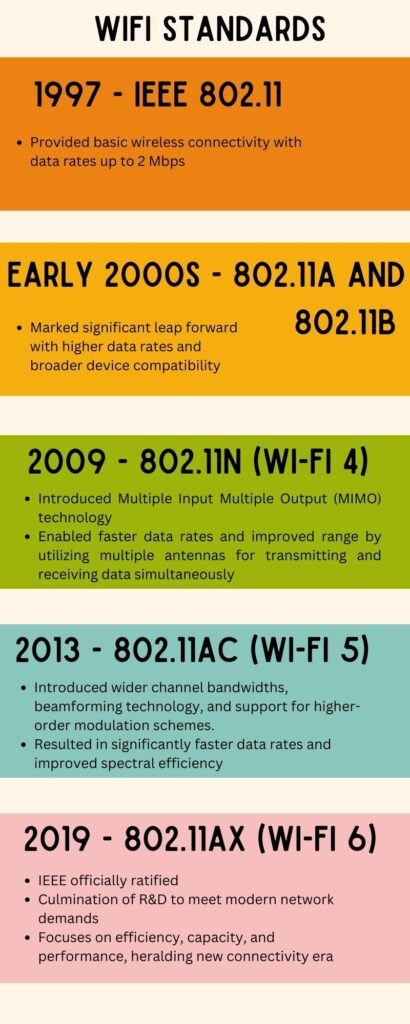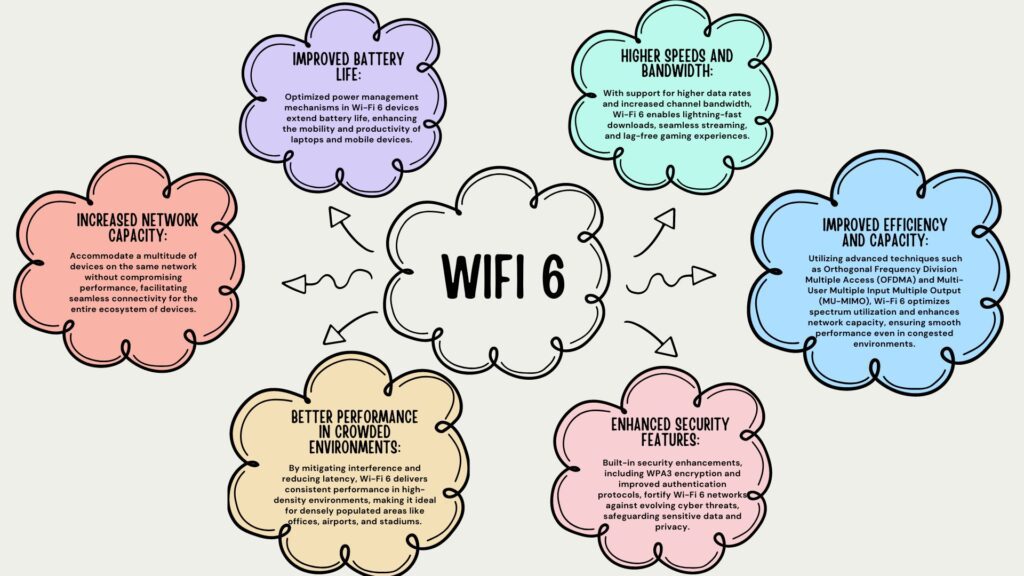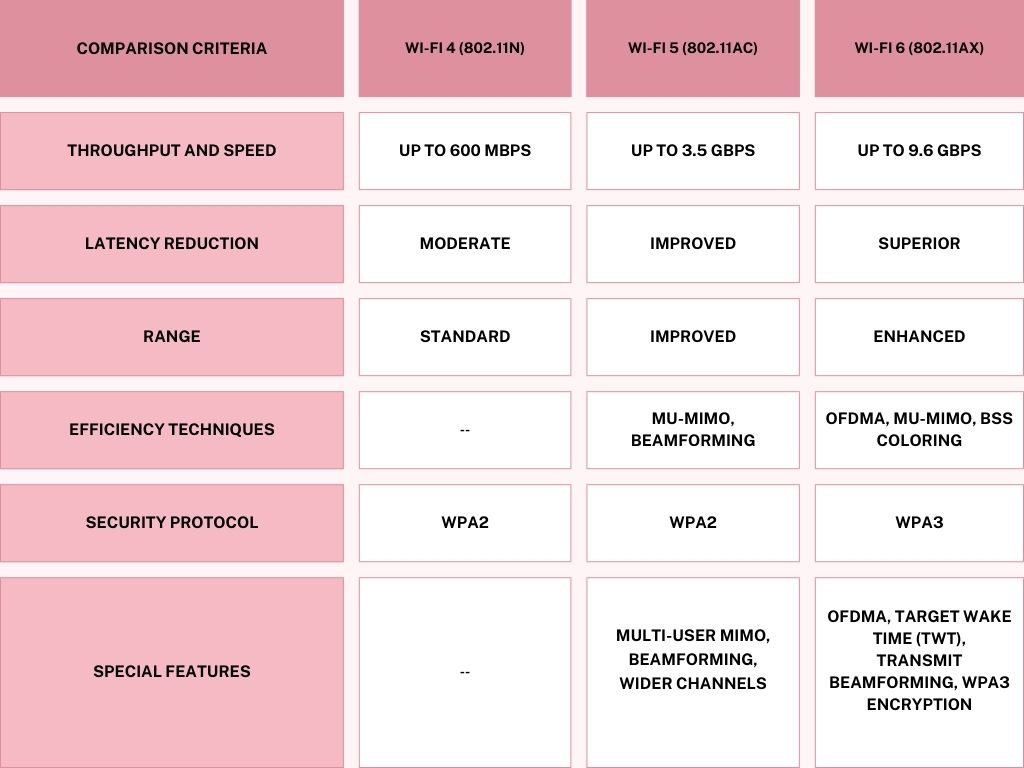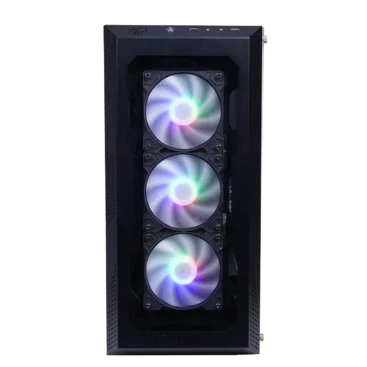
Next-Gen Connectivity: Wi-Fi 6 and Beyond
Introduction
The evolution of Wi-Fi standards has been a remarkable journey, with each new generation bringing significant improvements in speed, capacity, and efficiency. As we approach the era of Wi-Fi 6, it is essential to understand its impact on today’s digital landscape, especially for desktop and laptop users. With the increasing reliance on wireless connectivity for a wide range of applications, Wi-Fi 6 is poised to revolutionize the way we connect and communicate, particularly in the domain of desktop and laptop computing.
Evolution of Wi-Fi Standards
The evolution of Wi-Fi standards traces back to the early days of wireless communication when the IEEE 802.11 working group laid the foundation for what would become a revolutionary technology. Beginning with the release of the original 802.11 standard in 1997, which provided basic wireless connectivity with data rates up to 2 Mbps, the journey towards Wi-Fi 6 has been marked by a series of significant milestones and advancements.

As the demand for wireless connectivity surged, subsequent iterations of the standard sought to address key limitations and enhance performance. The introduction of 802.11a and 802.11b in the early 2000s marked a significant leap forward, offering higher data rates and compatibility with a broader range of devices. 802.11g followed suit, combining the best aspects of its predecessors to deliver faster speeds and improved reliability.
However, it was the advent of 802.11n, commonly referred to as Wi-Fi 4, that truly revolutionized the wireless landscape. Introduced in 2009, Wi-Fi 4 introduced Multiple Input Multiple Output (MIMO) technology, enabling faster data rates and improved range by utilizing multiple antennas for transmitting and receiving data simultaneously. This breakthrough paved the way for widespread adoption of Wi-Fi in both consumer and enterprise environments.
Building upon the foundation laid by Wi-Fi 4, the subsequent release of 802.11ac, or Wi-Fi 5, in 2013, represented another quantum leap in performance. Wi-Fi 5 introduced advancements such as wider channel bandwidths, beamforming technology, and support for higher-order modulation schemes, resulting in significantly faster data rates and improved spectral efficiency.
Amidst this backdrop of innovation and progress, the stage was set for the arrival of Wi-Fi 6, or 802.11ax. Officially ratified by the IEEE in 2019, Wi-Fi 6 represents the culmination of years of research and development aimed at addressing the ever-growing demands of modern wireless networks. With its focus on enhancing efficiency, capacity, and performance, Wi-Fi 6 heralds a new era of connectivity, poised to redefine the way we experience wireless communication.
In summary, the evolution of Wi-Fi standards has been characterized by a relentless pursuit of excellence, driven by the imperative to meet the evolving needs of users and applications. From humble beginnings to the cutting-edge technology of Wi-Fi 6, each iteration has brought us closer to the vision of ubiquitous, high-speed wireless connectivity. As we embark on the next chapter of this journey, the possibilities for innovation and advancement in wireless communication are truly limitless.
Wi-Fi 6 Technology Overview
Wi-Fi 6 heralds a new era of connectivity, marked by a plethora of innovative features and enhancements. At its core, Wi-Fi 6 delivers:
Higher Speeds and Bandwidth
With support for higher data rates and increased channel bandwidth, Wi-Fi 6 enables lightning-fast downloads, seamless streaming, and lag-free gaming experiences.
Improved Efficiency and Capacity
Utilizing advanced techniques such as Orthogonal Frequency Division Multiple Access (OFDMA) and Multi-User Multiple Input Multiple Output (MU-MIMO), Wi-Fi 6 optimizes spectrum utilization and enhances network capacity, ensuring smooth performance even in congested environments.
Enhanced Security Features
Built-in security enhancements, including WPA3 encryption and improved authentication protocols, fortify Wi-Fi 6 networks against evolving cyber threats, safeguarding sensitive data and privacy.
Better Performance in Crowded Environments
By mitigating interference and reducing latency, Wi-Fi 6 delivers consistent performance in high-density environments, making it ideal for densely populated areas like offices, airports, and stadiums.

Benefits of Wi-Fi 6
Faster Downloads and Uploads
Experience blazing-fast internet speeds for seamless content consumption, file transfers, and multimedia streaming.
More Reliable Connections
Enjoy stable and consistent connectivity, even in challenging wireless environments, ensuring uninterrupted productivity and communication.
Increased Network Capacity
Accommodate a multitude of devices on the same network without compromising performance, facilitating seamless connectivity for the entire ecosystem of devices.
Improved Battery Life
Optimized power management mechanisms in Wi-Fi 6 devices extend battery life, enhancing the mobility and productivity of laptops and mobile devices.
Better Performance for Bandwidth-Intensive Applications
From video conferencing and online gaming to 4K video streaming, Wi-Fi 6 empowers users to indulge in bandwidth-intensive activities without compromise, thanks to its superior throughput and efficiency.
Comparison to Previous Wi-Fi Standards
The evolution of Wi-Fi standards has been a journey marked by continuous innovation and advancement, each iteration building upon the achievements of its predecessors. With the introduction of Wi-Fi 6 (802.11ax), the wireless landscape has once again undergone a significant transformation, promising unparalleled speed, efficiency, and reliability. We will see comparisons of Wi-Fi 6 with its predecessors, Wi-Fi 5 (802.11ac) and Wi-Fi 4 (802.11n), across key parameters to understand the magnitude of improvements and benefits brought forth by this groundbreaking technology.

Throughput and Speed
One of the most notable advancements in Wi-Fi 6 compared to previous standards is its remarkable increase in throughput and speed. While Wi-Fi 4 and Wi-Fi 5 offered impressive data rates, with Wi-Fi 4 reaching up to 600 Mbps and Wi-Fi 5 up to 3.5 Gbps, Wi-Fi 6 takes it to a whole new level. With theoretical maximum speeds of up to 9.6 Gbps, Wi-Fi 6 boasts significantly higher throughput, enabling lightning-fast downloads, seamless streaming, and lag-free gaming experiences.
Latency and Range
Reducing latency and extending range have been focal points of Wi-Fi development, and Wi-Fi 6 delivers substantial improvements in these areas. Through advanced technologies like Orthogonal Frequency Division Multiple Access (OFDMA) and Target Wake Time (TWT), Wi-Fi 6 significantly reduces latency and enhances range performance compared to its predecessors. This ensures smoother and more responsive connectivity, even in challenging wireless environments.
Efficiency and Capacity
Wi-Fi 6 introduces revolutionary techniques to optimize spectrum utilization and enhance network capacity, addressing the growing demands of modern wireless networks. Features like OFDMA, Multi-User Multiple Input Multiple Output (MU-MIMO), and Basic Service Set (BSS) Coloring allow Wi-Fi 6 networks to support a larger number of devices simultaneously, without compromising performance. This translates into a more efficient and robust wireless experience, particularly in high-density environments like offices, airports, and stadiums.
Security Upgrades
Security remains a top priority in wireless communication, and Wi-Fi 6 introduces several enhancements to fortify network defenses against evolving cyber threats. With the introduction of WPA3 encryption and improved authentication protocols, Wi-Fi 6 networks offer superior protection for sensitive data and privacy compared to its predecessors. This ensures peace of mind for users, knowing that their wireless connections are safeguarded against unauthorized access and malicious attacks.
Real-World Deployment and Use Cases:
Wi-Fi 6 (802.11ax) is being implemented and utilized in practical settings. This section explores the various scenarios where Wi-Fi 6 is being deployed and the specific applications and benefits it offers in those environments.
Home and Small Office Networking
- In home and small office environments, Wi-Fi 6 is being deployed to provide faster and more reliable wireless connectivity for a growing number of devices.
- With the increasing number of smart home devices, such as smart TVs, thermostats, and security cameras, Wi-Fi 6 can support simultaneous connections and ensure smooth performance for all devices.
- Features like OFDMA and MU-MIMO enable better handling of multiple devices, reducing congestion and improving overall network efficiency.
Corporate and Enterprise Environments
- Wi-Fi 6 is gaining traction in corporate and enterprise settings due to its ability to handle a large number of concurrent users and bandwidth-intensive applications.
- In offices, Wi-Fi 6 ensures seamless connectivity for employees using laptops, smartphones, and other devices for tasks such as video conferencing, file sharing, and cloud computing.
- Enhanced security features, such as WPA3 encryption, provide better protection for sensitive corporate data and communications.
High-Density Public Spaces
- Wi-Fi 6 is well-suited for high-density public spaces like airports, stadiums, convention centers, and shopping malls, where large crowds of people gather and connect to wireless networks simultaneously.
- The improved capacity and efficiency of Wi-Fi 6 help mitigate network congestion and ensure a consistent and reliable connection for users, even in crowded environments.
- Features like BSS Coloring and spatial reuse optimize spectrum utilization, allowing for more efficient coexistence of multiple access points and reducing interference.
IoT and Smart Home Applications
- Wi-Fi 6 plays a crucial role in supporting the proliferation of IoT devices and smart home applications.
- With Wi-Fi 6, smart home devices can communicate more efficiently, enabling faster response times and better interoperability between devices.
- The increased network capacity and improved battery life of Wi-Fi 6 devices make them ideal for powering a wide range of IoT sensors, actuators, and smart appliances.
Overall, Wi-Fi 6 deployment in real-world scenarios is driven by the need for faster speeds, better coverage, increased capacity, and improved reliability across a diverse range of environments and applications. As the adoption of Wi-Fi 6 continues to grow, it is expected to redefine the way we connect and interact with wireless networks, ushering in a new era of connectivity.

Future Outlook and Emerging Technologies:
As we look beyond Wi-Fi 6, the future of wireless technology is exciting. Here are some potential advancements and emerging technologies in the field of wireless connectivity:
Wi-Fi 7 (802.11be)
The next iteration of Wi-Fi, known as Wi-Fi 7 or 802.11be, is already on the horizon. It’s expected to offer even higher data rates (potentially up to 30 Gbps), lower latency, and improved efficiency. Wi-Fi 7 will likely continue to enhance the features introduced in Wi-Fi 6, such as OFDMA and MU-MIMO, while introducing new technologies like coordinated multi-user MIMO.
Integration with 5G
The integration of Wi-Fi 6 with 5G networks is another promising development. 5G is the next generation of cellular technology, offering high speeds, low latency, and the ability to connect a massive number of devices simultaneously. The convergence of Wi-Fi 6 and 5G could provide seamless, ultra-fast connectivity both indoors and outdoors.
Advancements in Wireless Communication Protocols
Emerging wireless communication protocols like WiGig (802.11ad and 802.11ay) are designed for short-range, high-speed data transfers, potentially up to 20 Gbps. These could complement Wi-Fi by providing high-speed connectivity for specific applications, such as VR/AR, uncompressed video streaming, and quick file transfers.
AI and Machine Learning
Artificial Intelligence (AI) and Machine Learning (ML) are set to play a significant role in the future of wireless connectivity. They can be used to optimize network performance, predict and mitigate issues, and provide personalized experiences. For example, AI could be used to intelligently manage network traffic, ensuring each device gets the bandwidth it needs for optimal performance.
Enhanced Security
As wireless connectivity becomes increasingly integral to our daily lives, security will continue to be a critical concern. Future Wi-Fi standards will likely introduce even more robust security features to protect against evolving threats. This could include more advanced encryption methods, improved user authentication, and features designed to maintain privacy.
The future of wireless connectivity is bright, with many exciting advancements on the horizon. As we move towards a more connected world, technologies like Wi-Fi 6 and beyond will play a crucial role in enabling seamless, secure, and high-speed connections.
Conclusion
As we conclude our exploration into Next-Gen Connectivity with a focus on Wi-Fi 6 and beyond, it becomes evident that we stand at the threshold of a transformative era in wireless communication. The journey of Wi-Fi standards, from the inception of 802.11 to the groundbreaking advancements of Wi-Fi 6, reflects a relentless pursuit of excellence driven by the evolving needs of users and applications.
Wi-Fi 6 represents the pinnacle of this evolution, offering unprecedented speed, efficiency, and reliability to meet the demands of today’s digital landscape. With its higher speeds and bandwidth, improved efficiency and capacity, enhanced security features, and better performance in crowded environments, Wi-Fi 6 promises to revolutionize the way we connect and communicate.
The benefits of Wi-Fi 6 extend beyond mere connectivity. Faster downloads and uploads, more reliable connections, increased network capacity, improved battery life, and better performance for bandwidth-intensive applications pave the way for enhanced productivity, seamless collaboration, and enriched digital experiences.
Moreover, Wi-Fi 6 is not an endpoint but a stepping stone towards even greater advancements in wireless technology. The future outlook is promising, with emerging technologies like Wi-Fi 7, integration with 5G networks, advancements in wireless communication protocols, and the integration of AI and machine learning poised to further redefine the possibilities of wireless connectivity.
As a leading manufacturer of laptops and desktops, we recognize the importance of staying at the forefront of technological innovation. Through this white paper, our aim is not only to educate users about Wi-Fi 6 but also to inspire them to embrace the possibilities of Next-Gen Connectivity. By leveraging the power of Wi-Fi 6 and beyond, we empower users to unlock new levels of productivity, creativity, and connectivity in their digital journeys.
In conclusion, the future of wireless connectivity is bright, and we are excited to be a part of this journey towards a more connected and empowered world. Together, let us embrace the possibilities of Next-Gen Connectivity and pave the way for a future where seamless, high-speed wireless connectivity enriches every aspect of our lives.
Recent Blogs
Holoware Laptops on EMI for Your Next Device
Startup Scheme for Laptops in India: Growth with Holo50
Holoware: The Best Selling Laptop in India
Best Laptop for Artificial Intelligence in India - Holoware Guide
Best SSD Laptops: Speed, Evolution & Why Holoware Stands Out
Unleashing the i7 Processor Power with Holoware
Choosing the Perfect IPS Screen Laptop by Holoware
Holoware - Choosing a Laptop with Dedicated Graphics Card
Holoware's Best Budget Laptop for Programming
i9 Processor Laptops: Power & Performance at Holoware
About Holoware
Products & Services
Useful Links
©2024 Holoware® Computers Pvt. Ltd. | Site Map | Privacy Policy | Terms & Condition
AI Laptop


Location: Porur,Chennai
No of Openings: 1
Join our team as a Senior Accounts Executive, where you’ll manage client relationships and implement innovative financial strategies. Your expertise in analyzing account performance will drive growth and foster lasting partnerships. If you’re ready to make an impact, we want to hear from you.
Roles and Responsibilities:
- Daily Accounts Receivable Management: Execute daily credit accounting in Tally Prime to ensure accurate financial records.
- Accounts Receivable and Credit Control Management: Administer the accounts receivable process and implement credit control measures to optimize cash flow.
- Invoice Processing and Material Transfers: Handle invoice cancellations and efficiently oversee the transfer of materials to the warehouse.
- Sales Returns and Order Cancellations Management: Process sales returns, record entries, create Post Goods Issues (PGI), and reverse canceled orders for precise sales tracking.
- Dealer Loan Recovery Supervision: Manage the recovery of dealer loans, accurately reflecting these amounts as recoverable income.
- Dealer Debit Data Reporting: Upload monthly dealer debit information to Power BI through Microsoft Azure for accurate financial analysis.
- Bank Reconciliation Tasks: Conduct detailed bank reconciliations to ensure transaction accuracy and resolve any discrepancies.
- Customer Account Reconciliation: Reconcile customer accounts with the General Ledger (GL) to ensure data consistency and accuracy.
- General Ledger Review: Perform monthly reviews of GL accounts to ensure compliance and accuracy in financial reporting.
- Monthly Sales Report Preparation: Compile and present monthly sales flash reports, offering insights into sales performance and trends.
- Monthly Financial Closing Procedures: Manage the monthly closing process, finalizing financial statements and recording all transactions.
- Tax Compliance Management: Prepare and submit Tax Deducted at Source (TDS) returns and issue Form 16 and Form 16A for compliance purposes.
- Employee Payroll Administration: Oversee the timely and accurate processing of employee salaries in line with payroll policies.
- Project Bills and Payment Oversight: Oversee the management of project bills payable, ensuring timely processing of payments to vendors and contractors.
- Project Budget Allocation Management: Allocate project budgets according to expense categories, ensuring effective financial resource utilization.
- GST Compliance Oversight: Manage Goods and Services Tax (GST) returns and TDS calculations to ensure accurate reporting and compliance.
- Audit Coordination: Collaborate with internal and external auditors, providing all necessary documentation for smooth audit processes.
- Audit Process Coordination: Facilitate internal and Auditor General (AG) audits by preparing all necessary documentation for review.
- Government Fund Allocation Liaison: Work with government agencies to coordinate fund allocations, ensuring compliance with regulations.
- Monthly Management Information Reporting: Prepare and present detailed Monthly Management Information System (MIS) reports to senior management.
Key Skills:
- Accounting
- Financial Reporting
- Tally Prime
- Data Analysis
- Reconciliation
- Tax Compliance
- Negotiation
- Problem-Solving
- Time Management
- Team Collaboration
- Vendor Management
Location: Porur,Chennai
No of Openings: 4
Join our team as a Senior Hardware Engineer to design and optimize state-of-the-art computing systems. You’ll leverage your expertise to innovate hardware solutions, ensuring peak performance and reliability in our products. Collaborate with a talented team to tackle complex challenges and help shape the future of technology.
Roles & Responsibilities:
- Lead the assembly process of desktops, laptops, and servers ensuring adherence to technical specifications and quality standards.
- Supervise and train a team of assembly technicians and junior engineers, providing guidance and feedback.
- Collaborate with the R&D and design teams to implement manufacturing processes for new products.
- Develop and optimize workflow to increase efficiency and reduce assembly times and costs.
- Maintain detailed documentation of assembly procedures and product modifications.
- Conduct quality control checks and troubleshoot hardware issues before final product release.
- Ensure compliance with safety standards and regulations in the assembly line.
- Manage inventory of parts and tools required for assembly processes.
- Stay updated with industry trends, new technology, and best practices in hardware assembly.
Preferred candidate profile:
- Bachelor’s degree in Electrical Engineering, Mechanical Engineering, or a related field.
- Minimum of 5 years of experience in hardware assembly, preferably focusing on PCs, laptops, and servers.
- The maximum age limit is 42 years
- Proven track record of leading a team in a manufacturing or assembly environment.
- Strong technical skills with a deep understanding of computer hardware components and assembly techniques.
- Excellent problem-solving skills and attention to detail.
- Proficient in using assembly tools and equipment.
- Certifications related to hardware assembly or project management.
- Experience in an ISO-certified or other regulated environment.
Key Skills:
- Service Engineering
- Hardware Networking
- Computer Hardware
- Team Leading
- Chip Level Repairing
- After Sales – Service and Support
- Computer Assembling
Location: Porur,Chennai
No of Openings: 2
Seeking a Senior Executive – International Purchase to spearhead global procurement strategies and secure top-tier suppliers. Harness your expertise to drive cost efficiencies, negotiate high-impact deals, and ensure seamless cross-border operations. Ideal candidates excel in strategic sourcing and thrive in a dynamic, fast-paced environment. Elevate our international purchasing with your strategic vision and industry insight.
Roles and Responsibilities:
- Develop and implement procurement strategies that are cost-effective and aligned with the company’s production needs and budget constraints.
- Identify, evaluate, and select reliable vendors and suppliers. Negotiate contracts and terms of agreements to achieve favourable pricing and delivery terms.
- Maintain optimal levels of inventory to ensure uninterrupted production schedules while minimizing carrying costs and obsolescence.
- Ensure that all purchased items meet quality standards and specifications required by the production process.
- Monitor and control procurement budgets and expenditures. Implement cost-saving initiatives without compromising on quality or reliability.
- Coordinate with production planning and logistics teams to ensure timely availability of materials and components.
- Stay updated with regulatory requirements and ensure procurement activities comply with legal standards and company policies.
- Identify potential risks in the supply chain and develop mitigation strategies to avoid disruptions in production.
- Analyse procurement data and market trends to make informed decisions and optimize purchasing strategies.
- Build and maintain strong relationships with vendors, suppliers, and internal stakeholders to foster collaboration and achieve mutual goals.
Preferred Candidate Profile:
- Proven experience as a Purchase or in a similar role.
- Should have a strong International Procurement experience.
- Strong negotiation skills and the ability to build long-term relationships with suppliers.
- Excellent communication and interpersonal skills.
- Familiarity with supply chain processes and inventory management.
- Bachelors degree in Business Administration, Supply Chain Management, or relevant field.
Location: Porur,Chennai
No of Openings: 2
Dynamic Logistics Executive sought to streamline supply chain operations and optimize distribution networks. Leverage your expertise to drive efficiency, enhance customer satisfaction, and lead innovative solutions. Ideal candidates are proactive problem-solvers with a knack for strategic planning and team leadership. Join us to make a tangible impact in a fast-paced environment!
Roles and Responsibilities:
Imports:
- Receiving the documents from overseas Agents.
- Documents are forwarded to various Liner for IGM filing purposes.
- Follow up on the vessel status for all import shipments through online.
- Providing the vessel details and the IGM number to the consignee once their shipment arrives.
- Issuing the Delivery order to a variety of consignees.
- Regular communication with All Liners/Consignee & Overseas Agent for all Import Shipments.
- As per the Shipper Invoice & Packing List, have prepared the shipment checklist.
- Preparing the necessary documents for clearance purposes
- Regular interaction with Liner for all the shipments.
- BE filing follow-up with CHA and transport movement
- Follow up on the status of all the shipments and inform the same to the respective shipper
- Preparing the Invoices of Various parties.
- Planning for day-to-day clearance on a priority basis.
Exports:
- Booking the cargo for all export shipments to Liner / Consolidator.
- Arranging the Container Release order from the liner and forwarding to the Shipper or CHA
- Informing liner to post the form-13 to CHA ID
- Follow up the container to load on the booking vessel.
- Preparing the Bill of Lading through on-line to various sector
- Based on the Liner invoice, have generated our Invoice for Customers.
- Issuing the Bill of Lading/COO/SCOMET
- Co-ordinating with all Overseas agents/Liner / Shipper/CHA for all export shipments.
- Scrutiny the Freight rates from the Liner / Consolidator and provide the best rate to the shipper).
- SB filing follow-up with CHA and transport movement
Preferred Candidates Profile:
- Tally /SAP/ERP knowledge required.
- Should be strong in Shipping INCOTERMS
- Preparing the Profit & Loss for all shipments (Import & Export)
Location: Bangalore, Hyderabad & Mumbai
No of Openings: 5
We are seeking a Key Account Manager for Corporate Sales who plays a crucial role in driving revenue growth, maintaining strong client relationships, and ensuring customer satisfaction within key accounts. Their responsibilities require a blend of strategic thinking, interpersonal skills, and a deep understanding of both the client’s business and their own company’s offerings.
Preferred Candidate profile:
- Excellent communication, interpersonal and relationship-building skills
- Should have a strong experience in B2B sales.
- Ability to work both independently and collaboratively in a team setting.
- Keen analytical skills and a strategic mindset.
- Willingness to travel for business purposes.
- Proven track record in lead generation and communication
- Ability to work independently and collaboratively
- Experience in the IT hardware/ Technology industry is a plus
- Experience in handling the IT/ITES, Manufacturing, Engineering, Media, BFSI Enterprise accounts is a plus
- Knowledge of IT hardware products is a plus
- Languages: Local Regional language and English are a must; Tamil & Hindi will be an added advantage.
- Preferred experience is 5 to 12 years in the relevant field.
Roles & Responsibilities:
- Establishing and maintaining a strong rapport with the enterprise accounts and the Channel partners in the assigned territories.
- Develop and execute strategic plans to achieve sales targets and expand the company’s customer base within key accounts
- Responsible for selling Artificial Intelligence (AI) Laptops, PCs and other Business Laptop, Executive Laptop, Desktops & Workstations.
- Coordinate with internal teams to ensure contract specifications are met on schedule.
- Analyse market trends and competitor activities to adjust strategies accordingly.
- Create and present detailed reports and presentations for various stakeholders.
- Business Development, Meeting the customers F2F Daily.
- Getting new Logos, generating leads, and providing excellent customer service.
- Drive existing accounts and get new business through SI’s and Large partners.
Location: Porur,Chennai
Languages: Hindi, Kannada, Telugu, Malayalam
No of Openings: 5
We are seeking a motivated and detail-oriented Business Analyst to join our dynamic sales team. The Business Analyst will play a key role in supporting our sales representatives and ensuring smooth operations within the sales department. This position offers an exciting opportunity to contribute to the success of our sales initiatives and provide excellent customer service to our clients.
Roles and Responsibilities:
- Identify potential customers interested in laptops, desktops, and tablets.
- Reach out to these prospects via phone or email to introduce the products.
- Discuss with customers to determine their specific requirements and preferences.
- Recommend and demonstrate the laptops, desktops, and tablets that best fit their needs.
- Track and manage leads through the sales cycle using CRM tools.
- Negotiate terms and close sales for the desired devices.
- Maintain communication with clients to ensure their satisfaction and encourage repeat business.
- Provide updates on sales performance and progress towards targets.
- Coordinate with technical support and product teams to address any issues or questions.
- Prepare and manage quotes, orders, and other sales-related documentation.
Preferred Candidates Profile:
- A bachelor’s degree in business administration, marketing, or a related field is preferred.
- Hindi or other regional languages are preferred.
- Proven experience in a sales support or coordination role, preferably in the technology industry.
- Strong organizational skills with the ability to manage multiple tasks simultaneously and prioritize effectively.
- Excellent communication and interpersonal skills, with a customer-focused approach.
- Proficiency in Microsoft Office suite (Word, Excel, PowerPoint) and CRM software.
- Attention to detail and high accuracy in data entry and record-keeping.
- Ability to work independently and as part of a team in a fast-paced environment.
- Positive attitude, willingness to learn, and adaptability to changing priorities.
Perks and Benefits:
- Opportunity to work with cutting-edge technology and innovative products.
- Collaborative and supportive work environment.
- Career growth and development opportunities within a growing company.
- Make a meaningful impact by contributing to the success of our sales team and driving business growth.
Location: Bangalore & Kochi
No of Openings: 2
We are seeking a Government Sales Specialist with exceptional communication skills and a deep understanding of government operations and procurement processes. This role is ideal for individuals with a strong background in public administration or related fields, who are adept at strategic engagement and building a long-term governmental relationship.
Preferred Candidate profile:
- Proven track record in sales with a focus on government sector engagements.
- Able to manage the GeM (Govt e-Marketplace) portal and Govt tenders.
- Exceptional verbal and written communication skills.
- Strong experience working with CXOs & Procurement Managers.
- Should have a strong experience in stock & sell.
- Ability to work both independently and collaboratively in a team setting.
- Keen analytical skills and a strategic mindset.
- Willingness to travel for business purposes.
- Preferred experience is 5 to 12 years in the relevant field.
- Strong knowledge in handling the state & central government departments within the whole Kerala/Karnataka/Mumbai state.
Roles & Responsibilities:
- Develop and implement effective sales strategies tailored to government sectors.
- Navigate and comply with government procurement policies and regulations.
- Build and maintain robust relationships with key stakeholders within government entities.
- Responsible for selling Artificial Intelligence (AI) Laptops, PCs and other Business Laptop, Executive Laptop, Desktops & Workstations.
- Coordinate with internal teams to ensure contract specifications are met on schedule.
- Analyze market trends and competitor activities to adjust strategies accordingly.
- Create and present detailed reports and presentations for various stakeholders.
Location: Porur,Chennai
No of Openings: 5
As a Level 2 Customer Support Specialist, you will serve as the primary point of contact for customers requiring advanced technical support for desktop/laptop-related issues. You will troubleshoot, resolve, and escalate complex problems, providing exceptional customer service and ensuring customer satisfaction.
Roles and Responsibilities:
- Respond to customer inquiries via phone, email, or chat, resolving Level 2 technical issues related to desktop/laptop hardware, software, and peripherals.
- Troubleshoot and diagnose complex problems using advanced technical knowledge and tools.
- Provide timely and effective solutions, escalating issues to senior technicians or management when necessary.
- Document customer interactions, issues, and resolutions in our CRM system.
- Collaborate with internal teams (e.g., sales, technical) to resolve customer concerns and improve processes.
- Stay up-to-date with industry developments, new technologies, and company products/services.
- Meet or exceed customer satisfaction, first-call resolution, and other performance metrics.
Preferred Candidates Profile:
- 2+ years of experience in technical support, preferably in a desktop/laptop service company.
- Advanced knowledge of desktop/laptop hardware, software, and peripherals.
- Excellent problem-solving, analytical, and communication skills.
- Ability to work in a fast-paced environment, prioritizing tasks and managing time effectively.
- Strong customer service skills, with a focus on empathy and professionalism.
[contact-form-7 id=”f0c372f” title=”Enterprise”]
Rugged Laptop
Rugged Tablet
Tablets
Demo Available*
Inquire About Rental Options
Warranty Offers
- Extended Protection: Warranty offers cover repairs and replacements for hardware failures or defects, saving significant costs on expensive components.
- Professional Support: They provide access to authorized service centers and professional support, ensuring quality repairs with genuine parts.
Services with those steps are available
- Accidental Damage Coverage: Some warranties include coverage for accidental damage, such as drops or spills, providing extra protection beyond standard defects.
- Technical Support: Many warranties offer round-the-clock technical support to help with troubleshooting and resolving software or hardware issues.
- Data Recovery Services: In case of hardware failure, some warranty plans include data recovery services to help retrieve important files and documents.
Solution With 24/7 Support
- 24/7 Technical Support: Many warranty plans provide round-the-clock technical support to assist with troubleshooting and resolving software or hardware issues at any time.
- On-Site Repairs: Certain warranty plans offer on-site repair services, where technicians come to your location to fix issues, minimizing downtime.
- Loaner Devices: Some warranties provide loaner devices while your laptop is being repaired, ensuring you stay productive without interruption.
- Global Coverage: For frequent travelers, some warranty plans offer global coverage, ensuring you can get support and repairs no matter where you are
Get Started
Book Your Demo

In 1994, Mr.Thangavel started Origin Information Technology (in partnership with Mr. Loganathan) to provide quality computer hardware sales and service. In the year 2022, the company name was changed to “Tinkas Industries Private Limited” to encompass its diversified activities. Mr. Thangavel feels that he can give back to his nation the growth it needs in many ways like providing employment opportunities to many, and doing CSR activities, etc. His goal is to make Tinkas a leader at the National and Internaltional levels.
Holoware CEO abut Tinkas CEO
“The CEO of Tinkas (Mr.Thangavel) is undeniably one of the most practical and resourceful individuals I’ve encountered in Tamil Nadu. His profound understanding of the industry coupled with his diverse business ventures truly exemplifies his wealth of knowledge. Partnering with Tinkas has been a delight, and we eagerly anticipate further growth and collaboration.”
Mr. Ketan Patel is an indomitable entrepreneur revolutionizing the landscape of electronic consumer products worldwide through an unparalleled ‘experiential journey.’ Leading Creative Newtech since 1992, he steered its growth from a Mumbai market trader to a distributor and Brand Licensee. As an alumnus of IIM-Bangalore, Mr Patel leads Creative Newtech with a focus on innovation and strategic leadership. Under his three-decade leadership, Creative Newtech has become India’s market leader, expanding globally across Hong Kong, the Middle East, and the SAARC region.”
Holoware CEO abut Creative Newtech CEO
“The CEO of Creative (Mr.Ketan Patel) is a highly knowledgeable leader, renowned for his expertise in distributorship. His intuitive knack for product selection and sales strategies, both in India and abroad, is impressive. Creative thrives as a powerhouse, fueled by its diverse team and collective expertise. We eagerly look forward to a promising future and further success in our collaboration with Creative.”

Inmac Computers Private Limited is a trailblazing name in the realm of IT services and solutions. With a remarkable inception in 1992 by visionary entrepreneurs Girish Babu and Asha Girish Babu, our company has consistently remained at the forefront of technological innovation, setting new standards for excellence in the industry.
Holoware CEO abut Inmac CEO
“Inmac’s CEO (Mr.Girish Babu) is one of the most humble and generous individuals I’ve ever had the pleasure of meeting. His leadership has been instrumental in steering his team to success, not just in Maharashtra but across various regions in India. Their financial stability over the years speaks volumes about his capabilities. It’s truly a delight to collaborate with someone of his caliber. I look forward to continued partnership with Inmac.”










